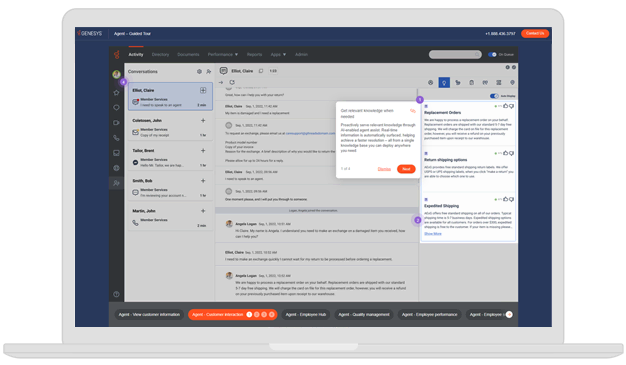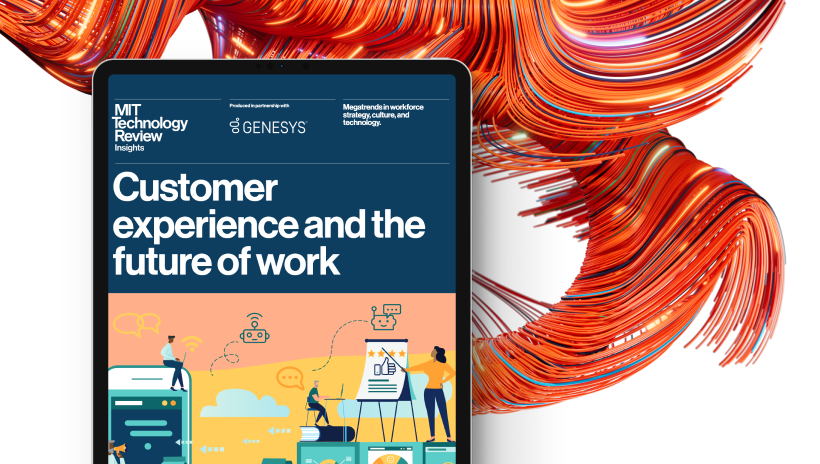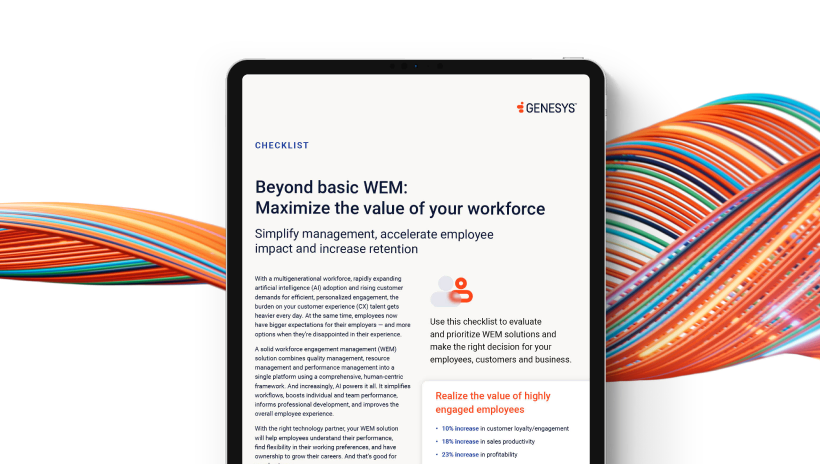Building and managing a high-performing workforce in an increasingly digital world can be challenging. But it’s not impossible — especially when you have all the pieces tightly woven together. When your tools and capabilities are seamlessly connected, your team will be fully equipped for success. You’ll be able to effectively manage workforce planning, control costs, and ensure employee and customer satisfaction.
Meeting expectations in an increasingly digital world
The challenges of managing a contact center — and a multi-skilled digital workforce — have multiplied dramatically. From forecasting and scheduling to managing, training, and equipping your team, the workforce planning process is becoming more complicated and more expensive. Employee expectations have changed, too. They want more flexible options in their schedules, and they want their managers to consider their preferences when planning. They also expect training for longer-term skills development.
New technologies that enable complex customer interactions across multiple channels, and meet the expectations of a modern workforce, come with their own issues. Too often, interaction channels are managed in silos. Many businesses still maintain separate systems for routing interactions and tasks, and for workforce management.
This creates complexity and manual work for the planning and operations teams. Getting relevant data from each of your point solutions is difficult enough. Making sense of all of it so you can plan for the future is even harder.
Additionally, manually planning and developing an accurate forecast and effective schedule in this environment takes a lot of time and effort. But with automation and tight integration with the contact center platform, you can reduce this time and effort while improving overall cost avoidance.
A good omnichannel workforce planning strategy can help improve the overall customer experience, reduce employee turnover through improved agent satisfaction and lower costs. It’s a three-pronged approach to having an engaged workforce, happy customers and business success. Let’s explore each of these business objectives.
1. Improve the customer experience
Today, improving customer experience (CX) is a critical part of any business strategy. From a tactical perspective, this is where meeting SLAs and improving KPIs across touchpoints and channels happens. To achieve this, your organization needs to have the right people with the right skills handling interactions at the right times.
Ensure customer interactions and tasks are going to the right resources
Misrouted interactions increase unplanned overtime costs, the number of call transfers and average handle times. However, having a workforce management system that’s integrated with your contact center platform and routing engine lets you consult the workforce schedule in real time.
This means interactions won’t be routed to employees who aren’t scheduled to work on a specific activity. It can also save on unplanned overtime costs. Employees will only receive interactions during a shift and with enough time left to complete a new task.
Boost efficiency and your bottom line
Accurate cross-channel planning and routing strategies based on real-time and historic information increase efficiency. These strategies allow the distribution of interactions and tasks to the most appropriate, skilled and available agents. And that results in faster and more productive resolutions.
Guarantee schedule adherence across all channels and work
It’s important to ensure employees are doing what they’re supposed to be doing when they’re supposed to be doing it. Using an integrated digital workforce management solution helps supervisors fight the schedule adherence battle. You can build schedules with shifts that span multiple activities across channels.
When integrated with your routing engine, the workforce planning solution provides schedule-based routing. That means shift transitions are managed automatically, and the operations team is firmly in control of task distribution logic. Ultimately, this closes workforce gaps and creates better experiences for your customers, employees and management.
2. Increase agent satisfaction and reduce turnover
Increasing employee engagement and satisfaction — as well as reducing employee turnover and its high costs — are all critically important. Ensuring your employees receive the right types of customer interactions and a variety of tasks throughout their shifts can relieve stress. And providing ongoing opportunities for skills and productivity improvements keeps employees motivated and engaged.
Make it easy for your employees
Employees need access to easy-to-use tools to request time off. This can be a big time-saver — especially if done through an integrated, agent-oriented web application. Providing employees with the ability to easily trade and bid on shifts helps you find the right balance between providing schedules that meet business objectives and giving team members the flexibility they want. In addition, by viewing schedules on their mobile devices, employees can stay engaged while away from the office.
Enable and engage your staff
Any good workforce planning strategy should include ongoing skills assessments and training. An accurate, up-to-date skills database is also a critical tool for any human resources or talent management team. Agent capabilities and skill sets are constantly evolving; handling different communication channels often requires different skills.
Typically, there’s little alignment between the training department, the workforce planners and the department that builds routing strategies. The key is tighter integration and tools that automatically schedule training sessions for times that don’t disrupt work. This ensures agents get the training they need without negatively affecting the business.
Ensure the right person gets the right work at the right time
Integrating workforce management tools with your platform and routing optimization helps reduce unnecessary overtime, as employees will only receive work if they have time to complete it. Plus, reducing misrouted interactions and work items relieves employee stress.
Giving employees more varied work, including different channels and tasks, relieves boredom and keeps them more interested and engaged. The result is reduced employee turnover, which is good for them and good for you.
Support remote working
Whether supporting work-from-home employees or expanding your call center locations across the globe, remote work and hybrid work are quickly becoming the new normal for organizations of all sizes. The ability to support all employees outside a physical call center is a necessity for any future workforce.
Advances in cloud technology have made all this possible. Remote workers need three tools: a computer that acts as a softphone, a headset or IP phone, and broadband data connection. Remote managers, though, need digital workforce management tools to enable them to navigate a team that’s spread across a city, country or world.
Build a multichannel digital strategy
As competitive pressures increase and customers want to communicate with you across more channels, it’s critical to modernize your contact center so your team can continue to meet these increasing demands.
Despite this fact, Dimension Data research shows nearly one-third (31.5%) of organizations don’t have a formally defined channel management strategy. Only 11% are now focused on implementing a full omnichannel strategy – down from 25% in 2019.1
With so many organizations still operating with dated systems, it’s more important than ever to develop a real omnichannel strategy. Simply being present in more channels isn’t enough. You need to build an experience that’s true to your business across each channel, catering to the specific audiences that want to interact with you on each one.
3. Reduce costs
Driving operational efficiency is a consistent goal of any well-run contact center. Through integration and automation, you can centralize control, reduce costs, and enable your processes and employees to be more efficient.
Simplicity, control and insight
Having an integrated solution lets you plan, forecast and schedule your workforce more accurately. From a broad perspective, it makes sense to integrate your communication channels into one platform. That single platform can integrate your workforce management system and optimize work distribution while increasing productivity.
From a more technical standpoint, it unifies the administration of users and skills while providing a single source of cross-channel insight into staff and business performance metrics.
“Perhaps the most important thing I have learned from my experience is the value of having a fully integrated forecasting and scheduling tool. When you can see the whole value chain, you get much greater insight into the way that the contact center performs and can make much more accurate forecasts.”
Grethe Smith-Meyer
Head of Resource Management
DNB
Automated workforce planning, accuracy and consistency
Executing skills and schedule updates in one place can dramatically reduce the time and costs associated with manual operation, daily skills and schedule changes. In addition, you have a wealth of information at your fingertips when your channels, workforce management and routing engine work together.
The automated use of historical data makes it possible to have greater accuracy in omnichannel forecasting. And that makes it easier to manage workforce planning at the right levels across channels and time.
Reality-based workload predictions and backlog handling
Effective workforce planning and management systems support every channel you work in with accurate, reality-based forecasting and rules-based routing.
An integrated solution lets you define service levels based on business rules and gather required statistics for all channels automatically. That way, you produce more accurate, channel-specific forecasts.
Having insight into service levels and tracking work within the queue means you can manage defined service levels, workloads and backlogs. And all that can be done consistently and effectively, across all channels and business processes.
Build a smarter business with digital workforce management
Our increasingly digital world presents challenges and benefits. But with the right technology, challenges like managing multiple communication channels and increasing customer expectations can quickly become benefits.
Improve customer experiences, enhance employee experiences and grow your business. Embrace the digital revolution with a move to the cloud. See what your digitally enhanced contact center can do by exploring this CX blueprint builder.
1 Source: Dimension Data 2019 Benchmarking Report





